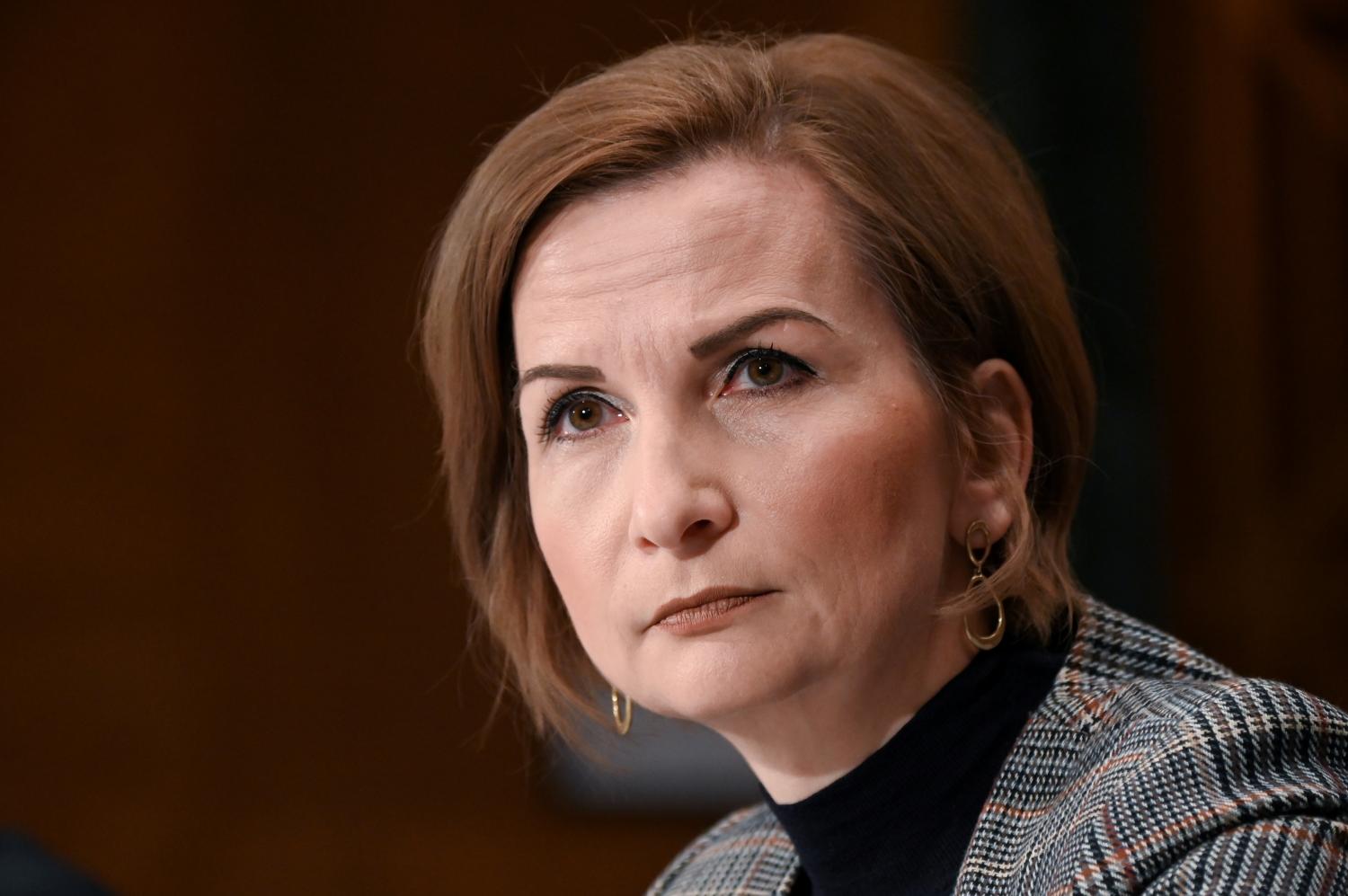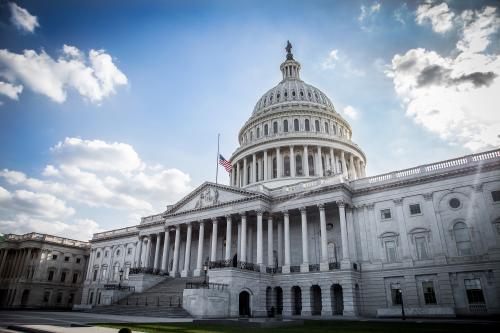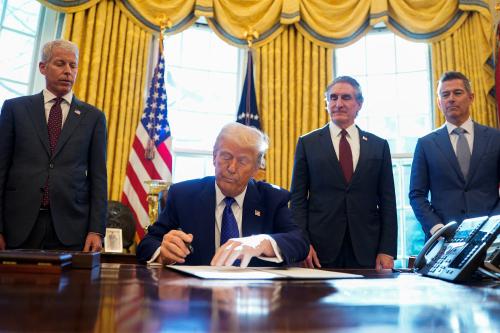2021 ended with a mini-crisis at the Federal Deposit Insurance Corporation (FDIC) resulting in the chair resigning after being outvoted by a majority of the board of directors. While this fight received substantial press attention, a similar fight occurred at the National Credit Union Administration (NCUA) where a majority of its board overruled its chair. These incidents highlight how financial regulators’ ability to function in the current politically polarized environment can depend on the agencies regulatory structure. A careful examination of recent trends shows trouble on the horizon for regulators of all shapes and sizes.
The threat is not just messy politics regarding boards. The ability of single-headed agencies to remain independent of the electoral swings is in doubt. Two recent Supreme Court decisions—featuring the new conservative majority—struck down provisions of two major laws that emerged from the last financial crisis which aimed at creating stronger regulations to address consumer financial protection (CFPB case) and the government-sponsored housing finance agencies (FHFA case). The Court effectively turned the head of each agency into an at-will appointee easily removed by any sitting president, overturning Congress’ intent to create agency heads serving fixed terms meant to provide independence from easy removal by the president. The ironic result—a conservative court removing Trump-appointed regulators—may provide short-term comfort to pro-regulatory progressives. But the longer-term ramifications of the Court’s rulings effectively curtail political independence of single agency headed regulators, which should give pause to progressives. Given the long time periods required to implement financial regulation and the political difficulties inherent in regulation that gave rise to the desire for agency independence, the end result of the Court’s ruling will probably be deregulatory.
The ability of financial regulators to be independent of the president and to function effectively is at stake, and it is not clear when, how, or what the final outcome will be. An advantage of the board structure was supposed to be consensus-driven policy subject to majority rule. An advantage of a single agency head with a long term who is non-removable by the president was supposed to be the ability of an agency to achieve politically-difficult regulatory outcomes. Both objectives are threatened by recent changes.
Background
Some background for those not steeped in America’s byzantine and bifurcated financial regulatory system. Financial regulators come in all shapes and sizes: single agency heads to seven-member boards; no partisan affiliation to strict partisan splits; boards consisting of people chosen specifically for that purpose to boards that consist of officials from other agencies. The chart below shows the various structures of financial regulators with the footnote containing the full name of each of the alphabet soup of regulators.1Financial Regulators by Agency Structure
| Agency Structure | Single Head | 3-Member Board | 5-Member Board | 7-Member Board |
| Agency | OCC, CFPB, FHFA, OFR | NCUA |
FDIC SEC CFTC |
Federal Reserve Board of Governors |
Financial regulators are designed to have a greater level of independence from both the executive and legislative branches of government to avoid political interference and more effectively carry out their statutory missions. Each of the agencies mentioned has some independence, with details varying (for more details see this in-depth Congressional Research Service report). Part of this independence involves serving fixed terms ranging from five to 14 years that outlast any specific four-year presidential term. Single agency heads, however, find themselves in a different position. The comptroller is subject to removal by the president for “reasons to be communicated to the Senate,” and two recent Supreme Court decisions struck down provisions of the laws creating the CFPB and FHFA, making each agency head subject to removal at will.
Boards vs. single agency heads
Scholars debate how to balance regulatory independence with public accountability, including how much regulatory structure between boards and single agency heads matters. Congress and presidents of both parties have recently preferred single agency heads as opposed to boards. Financial regulatory agencies are usually created in response to financial crises, and the three most recently created financial regulators, FHFA, CFPB, and OFR, were all created in response to the 2008 crisis. Each was given a single agency head with terms that extend beyond the tenure of a presidential administration and limits placed on their removal by future presidents. The laws that created the three were signed by Presidents Bush 43 (FHFA) and Obama (CFPB and OFR) and had varying degrees of bipartisan support. While this structure was popular, it has been transmuted by these Supreme Court cases into agencies whose heads serve at the will of the president and can be quickly removed and replaced if they are at odds with the White House.
Boards were the more common structure for financial regulators created in the 20th century. Proponents of boards argue that by bringing multiple perspectives, often with bipartisan requirements, agreements can be worked out between different political and regulatory philosophies by non-elected but appointed individuals. Term appointments that cannot be rescinded at will provide board members the autonomy to form agreements not supported by elected political officials.
Different rules govern the role and designation process for the chair between the regulators. For the Federal Reserve, the position and term of chairmanship is separable from a position on the Board. This distinction between chair and Fed Board member came into play when President Trump publicly contemplated firing Fed Chairman Powell. The law was clear that Trump could not remove Powell from the Fed Board, but less clear as to whether Trump could remove Powell from the chairmanship. This was important as the Fed’s monetary policy arm, the Federal Open Market Committee (FOMC), elects its own chair and could in theory have kept Powell as chairman of the FOMC regardless of any attempt by Trump to demote his standing at the Board. Thus, the manner in which regulatory boards are structured can enhance independence.
Bank regulatory boards: Majority rule?
The FDIC and NCUA currently have chairs who are in the political and policy minority. The FDIC has a majority of Democratic members converging to overrule the Republican chair. Their first action was a request for public comment regarding bank mergers and acquisitions. The FDIC chair disputed the ability of the majority of the agency to take action without her consent. The regulatory action taken, inviting comment for a review of bank merger regulation, is consistent with the priorities of the Biden administration as the White House encouraged the FDIC to update their merger guidelines in an executive order issued in July 2021.
The FDIC action is further complicated by the chair’s position that no action has been taken because she has not agreed to place the item on the agenda for a formal vote. The other FDIC board members take the position that they have voted on this topic with one board member placing the request for comment on his agency’s website. That these conflicting actions can occur is possible because, uniquely among financial regulators, the FDIC Board contains two heads of other agencies (CFPB and OCC) as members. These agency heads have access to post actions in the Federal Register and on their own websites in a manner that other agencies’ non-chair members do not necessarily have. The FDIC Chair announced her resignation on New Year’s Eve, defusing the current crisis. However, had she not chosen to resign, then either the situation would have ended up in the courts or the president would have had to try to remove her. Either would have been a messy situation, leading to a period where basic operation and control of the institution insuring American’s bank accounts was in fundamental doubt.
The ability of financial regulators to be independent of the president and to function effectively is at stake.
In contrast, the NCUA has seen the two non-chair Republican board members outvote the Democratic chairman to pursue a deregulatory agenda, approving rules deregulating lending requirements on so-called payday alternatives and activities of service organizations affiliated with the credit union. This deregulation is consistent with the conservative ideology of the Republican Trump appointees who have worked together to override the position of the Democratic appointee whom President Biden designated as chairman.
Two financial regulators are pursuing two opposite paths consistent with the standard political positions among the majority of their boards. The NCUA is deregulating while the FDIC is starting down the path to likely increase regulatory thresholds. The NCUA’s actions have earned the praise of credit union industry advocates while the FDIC’s actions have drawn rebukes by industry. Industry supporting deregulation and opposing regulation is not surprising, but it is important to note the role process plays in the debate. Praise of NCUA focuses on the actions of the majority of the board, while opposition to the FDIC focuses on the process. This is important because the method for a chair to avoid being overruled is to manipulate the process such that the board never has an opportunity to vote on an item. Control of the process can equate to control of the agency, regardless of the will of the majority.
Boards are expected to operate under majority rule, creating the potential for a board chair to be in the minority. This is what happened at the NCUA, which garnered little fanfare or media attention. It is not unique to the NCUA. While the Federal Reserve Board operated recently under substantial consensus, this was not always the case. The late Fed Chairman Paul Volcker was outvoted 4-3 on an issue before the Fed Board of Governors in the 1980s, as he detailed in his memoir. More recently, SEC Chairman Donaldson, a Bush appointee, joined with Democratic commissioners to pass a rule regarding mutual funds on a 3-2 vote. Regardless of the politics of the members involved, the principle of majority rule has held.
Should a chair be able to block a majority, the threshold for regulatory action becomes even greater. A five-member board needs both a majority (three members) and the chair. If FDIC Chair McWilliams had been able to set this precedent, it would raise another challenge for the FDIC to act going forward given that: two of the five members are heads of other agencies; that of the three FDIC full-time board members two are frequently of the minority party (in order to satisfy the no more than three members of the same party split required); and the natural hurdle of giving one member greater power to block action than to allow it.
Regulators run by a single agency head inherently escape the dilemma between the chair and the will of the majority of a board. Yet a single agency head that is not structurally independent of the sitting president is easily removed every time the White House flips. That is the situation the new financial regulators find themselves in after the Supreme Court’s two rulings mentioned earlier. The Supreme Court has checked the desire of Congress and presidents of both parties to structure new financial regulators as agencies headed by single individuals with this level of independence. This check had immediate ramifications. President Biden changed CFPB directors on day one of his presidency, a big contrast from his general lack of nominations to other bank regulatory boards (by December 20, 2021 Biden had not nominated a single new person to the Federal Reserve Board of Governors or the FDIC). Biden removed the FHFA director immediately after the Supreme Court issued its ruling on that case.
The long-term result of the Court’s actions will be regulators that are less independent and more politically controlled by the White House. Chief Justice Roberts’ ruling distinguishes between multi-member boards and single agency heads in finding differences as to the constitutionality of non-at-will appointments. Absent a change in the Supreme Court’s view of these issues, the creation of single agency head regulators will be confined to those easily replaced by presidents. One may disagree with this logic, but until reversed, it stands. The result will be a greater incentive for Congress to structure financial regulators as boards for greater independence from the executive branch.
2021 featured a credit union regulator with a board overriding the chair and a bank regulator in a battle with a chair who views the majority as attempting to “wrest control from an independent agency’s chairman with a change in the administration.” The FDIC chair’s resignation sets 2022 off in a new direction, defusing the immediate crisis, but the structural problems of both models of financial regulation—boards and single agency heads—still need to be addressed.
The Brookings Institution is financed through the support of a diverse array of foundations, corporations, governments, individuals, as well as an endowment. A list of donors can be found in our annual reports published online here. The findings, interpretations, and conclusions in this report are solely those of its author(s) and are not influenced by any donation.
-
Footnotes
-
The full name and responsibilities of each of the regulatory agencies is:
Office of the Comptroller of the Currency (OCC) – regulates national banks
Consumer Financial Protection Bureau (CFPB) – regulates financial products
Federal Housing Finance Agency (FHFA) – regulates government-sponsored housing agencies
Office of Financial Regulation (OFR) – regulates data, monitors for financial risks
National Credit Union Administration (NCUA) – regulates federal credit unions and insures credit union deposits
Federal Deposit Insurance Corporation (FDIC) – regulates state non-member banks and insures all bank deposits
Securities and Exchange Commission (SEC) – regulates securities markets
Commodities Futures Trading Corporation (CFTC) – regulates futures and commodities markets
Federal Reserve Board of Governors – regulates state member banks, all bank holding companies, payment systems, and all systemically important financial institutions
All of these regulators (and some others) are members of the Financial Stability Oversight Committee, a sort of Jedi Council of regulators chaired by the Treasury Secretary.
-
The full name and responsibilities of each of the regulatory agencies is:
Office of the Comptroller of the Currency (OCC) – regulates national banks
Consumer Financial Protection Bureau (CFPB) – regulates financial products
Federal Housing Finance Agency (FHFA) – regulates government-sponsored housing agencies
Office of Financial Regulation (OFR) – regulates data, monitors for financial risks
National Credit Union Administration (NCUA) – regulates federal credit unions and insures credit union deposits
Federal Deposit Insurance Corporation (FDIC) – regulates state non-member banks and insures all bank deposits
Securities and Exchange Commission (SEC) – regulates securities markets
Commodities Futures Trading Corporation (CFTC) – regulates futures and commodities markets
Federal Reserve Board of Governors – regulates state member banks, all bank holding companies, payment systems, and all systemically important financial institutions
All of these regulators (and some others) are members of the Financial Stability Oversight Committee, a sort of Jedi Council of regulators chaired by the Treasury Secretary.
The Brookings Institution is committed to quality, independence, and impact.
We are supported by a diverse array of funders. In line with our values and policies, each Brookings publication represents the sole views of its author(s).








